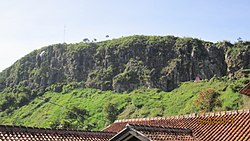You can help expand this article with text translated from the corresponding article in Indonesian. (July 2021) Click for important translation instructions.
|
| Lembang Fault | |
|---|---|
 A fault scarp of the lembang fault A fault scarp of the lembang fault | |
| Country | Indonesia |
| Region | West Java |
| Cities | Bandung |
| Characteristics | |
| Length | 29 km |
| Displacement | 1.95–3.45 mm/yr |
| Tectonics | |
| Status | active |
| Earthquakes | None recorded historically |
| Type | crustal |
| Movement | right-lateral strike-slip |
| Age | Pleistocene |
The Lembang Fault (Indonesian: Sesar Lembang) is an active fault located 10 km north of the city of Bandung on the Indonesian island of Java. This sinistral slip fault is estimated to measure 29 km in length. While no historical earthquakes have occurred, the fault is thought to be possible of generating a magnitude (Mw) 6.5 to 7.0 earthquake in the future. Because of the potential for large and damaging earthquakes on the fault, the Meteorology, Climatology and Geophysics Agency (BMKG) has been monitoring activity on the fault.
Activity
Paleoseismic trenching along the fault in a 2019 study uncovered three earthquakes in the 15th century, 2300–60 BCE and 19,620–19,140 BP with a recurrence interval of 170 to 670 years.
Threat
The Indonesian Institute of Sciences has urged that the Government of Indonesia educate the residents in nearby population centers about the dangers of a damaging earthquake on the fault.
In 2019, the BMKG said that 22 seismic monitoring devices would be installed around that fault to monitor its activity and detect movements.
Earthquakes can cause IDR 51 Trillion ($3.5 Billion) worth of damage, exceeding that of the 2004 Indian Ocean earthquake and tsunami. It is estimated that around 2.5 million homes would be affected, including one million lightly damaged. Another million others seriously damaged and 500 thousand homes collapsed. An estimated four million would be displaced and 180,000 injured and 80,000 may be killed.
References
- Eko Yulianto (2015). "Geological and tectonic implications obtained from first seismic activity investigation around Lembang fault". Geophysical Research Letters. 2 (4): 4. Bibcode:2015GSL.....2....4A. doi:10.1186/s40562-015-0020-5. S2CID 55403293.
- ^ Mudrik R. Daryono; Danny H. Natawidjaja; Benjamin Sapiie; Phil Cummins (2019). "Earthquake Geology of the Lembang Fault, West Java, Indonesia". Tectonophysics. 751: 180–191. Bibcode:2019Tectp.751..180D. doi:10.1016/j.tecto.2018.12.014. S2CID 133823206.
- "Mengenal Sesar Lembang, Patahan Gempa di Bandung yang Terus Aktif Sejak 1963" [Understanding the Lembang Fault, Earthquake Fault in Bandung Still Active Since 1963]. merdeka.com (in Indonesian). 28 January 2021.
- Arya Dipa (2011). "Scientists tout quake threat from Lembang fault near Bandung". The Jakarta Post. Retrieved 22 July 2021.
- Anwar Siswadi (2019). "BMKG Installs More Seismic Sensors along the Lembang Fault Line". Tempo. Retrieved 22 July 2021.
- "Inilah yang Terjadi saat Gempa Lembang Menghantam Bandung" [This Is What Happens When Lembang Earthquake Hits Bandung]. Tirto.id (in Indonesian). 20 October 2017.